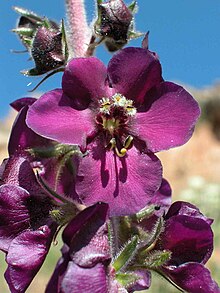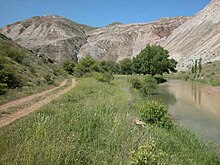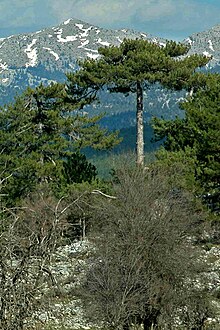Flora and Vegetation of Turkey


In 2000, around 9,300 species of wild vascular plants were known in what is now Turkey . For the whole of Europe around 11,500 species are specified, but on an area around thirteen times larger. Compared to Europe, Turkey is characterized by a remarkably high floristic diversity . The reason for this is probably the astonishingly high rate of endemism in connection with the extremely high ecological diversity of Anatolia .
Endemism
Almost every third Turkish plant species (30.6%) is limited in its total distribution to the area of today's Turkey including the nearby Aegean Islands , i.e. endemic there. In contrast, Austria has only 1.56% of endemics , and the values are similarly low for larger countries such as Germany and Great Britain. The mountainous land surface of Anatolia is usually considered to be the main cause of the high proportion of endemics. The high mountains there are often separated by plateaus, similar to islands. For Anatolia, this assumption is supported by concentrations of local endemics on particularly isolated and relatively old massifs such as Uludağ or Ilgaz Dağı . In contrast, young volcanic cones such as Erciyes Dağı or Hasan Dağı are relatively poor in endemics.

A second crucial difference is the completely different fate of the Alps and the Anatolian high mountains during the Ice Ages . In Anatolia, even during the peak of the Pleistocene glaciation, the ice caps were always limited to the highest peaks. This is why endemics were able to develop in many parts of Anatolia over long periods of time and also survive to the present day.

flora
By far the most species-rich genus of vascular plants in Anatolia is astragalus ( tragacanth ). It seems to be in the middle of the process of speciation, which often makes it very difficult for the non-specialist to distinguish between the many closely related clans. Tragante are particularly typical of treeless, dry habitats. Such were probably not rare in Inner Anatolia even in prehistoric times. However, they experienced a downright explosive spread through humans in historical times, which probably also strongly stimulated the formation of species. Depending on the respective environmental conditions, an astonishing variety of life forms has developed in the genus Astragalus , from tiny annual species to small shrubs and the thorn pads characteristic of the dry mountains of Central and South Anatolia. However, this life form, which protects against grazing as well as against summer drought, was not exclusively invented by Astragalus . Examples of co-directed (convergent) evolution are the impressive thorn pads of Onobrychis cornuta ( Fabaceae ) and Acantholimon sp. ( Plumbaginaceae ). Even some Asteraceae (in Turkey e.g. Centaurea urvillei , Centaurea iberica ) and Caryophyllaceae (e.g. Minuartia juniperina ) developed in this direction.
The second most important anatolische plant genus are the mullein ( Verbascum sp./ family Scrophulariaceae ), followed by the kind of the knapweed ( Centaurea sp./Familie Asteraceae ). As for the mullein, Anatolia is undoubtedly their center of distribution. Of around 360 species worldwide, 232 grow in Turkey, of which 79.4% only grow here, so they are endemic. Most Verbascum species protect themselves against water loss and hungry cattle by means of thick hairs made up of heavily branched hair. Knapweed species are seldom so densely hairy, but have developed thorny bracts or stemless forms that are pressed against the ground to defend themselves against the ubiquitous goats and sheep.
vegetation
In the extreme north of Anatolia, the Pontus forms a continuous barrier against the moist air flowing in from the Black Sea. This leads to high rainfall on the north face of the Pontus throughout the year. The climatic conditions on the Black Sea coast are therefore similar to those in Central Europe and the vegetation appears accordingly "Central European". Mediterranean vegetation influence can only be seen on a very narrow coastal strip. It is completely absent in the northeast. In lower altitudes north of the main Pontic ridge, the hornbeam ( Carpinus betulus ) often dominates , mostly mixed with the sweet chestnut ( Castanea sativa ). Higher up, the oriental beech ( Fagus orientalis ) and / or the Nordmann fir ( Abies nordmanniana ) form dense forests. In the northeastern Black Sea region ( Lazistan ), the Pontic Mountains reach their greatest heights in the almost 4000 m high Kaçkar Dağı . Accordingly, the annual rainfall is plentiful here. In addition, there is permanently high humidity, which - especially at heights of up to 2000 meters - leads to frequent fog formation. East of Trabzon , the vegetation therefore becomes almost subtropical, with many evergreen shrubs in the forests and tea plantations all over the lower slopes.
With the crossing of the Pontic watershed, the climate immediately becomes drier. In the direction of Inner Anatolia, the Nordmann fir first, but then the pine dominates. In western Anatolia it is often the black pine ( Pinus nigra ), in the east almost exclusively the red pine ( Pinus sylvestris ), which is less sensitive to the continental climate . The further you progress into central Anatolia, the drier and colder the conditions become. The extent to which the steppe vegetation occurring here is of natural origin or was created through forest desolation has not been definitively clarified. The lowest rainfall is south of Ankara in the area of the Great Salt Lake ( Tuz Gölü ) and especially in the Aras Valley on the Armenian border. Between Kağızman and Tuzluca , the Aras Valley is so dry that deposits of pure salt like white fields of snow glisten from the slopes.
The southern border of the Anatolian plateau is formed by the Taurus Mountains . Above all, its southern roof is fully in the area of influence of the Mediterranean climate , which means a lot of precipitation in winter, but dry and hot summer. Calculated over the whole year, Antalya has considerably more rainfall than London (1071 mm against 759 mm). But its seasonal distribution is completely different and the annual mean temperature is much higher (18.3 ° C against 9.7 ° C). High-altitude forests are formed by black pine, Cilician fir ( Abies cilicica ) and Lebanon cedar ( Cedrus libani ). Unfortunately, there has been a lot of overexploitation of these forests, mostly of the once rich cedar stands. In the natural vegetation of the very dry summer low areas of the Mediterranean coast, evergreen trees such as Kermes oak ( Quercus coccifera ) and Calabrian pine ( Pinus brutia ) dominate the natural vegetation . However, due to the massive destruction of forests, the hills of the coastal areas are largely covered with maquis or karstified. Intensive agriculture is practiced where fertile alluvial soils predominate, for example in the Cilician Plain around Adana .
Extensive hazelnut fields ( Corylus maxima ) cover large areas of the more mountainous parts of the Turkish Black Sea coast. To the east of Trabzon they are replaced by tea. - at Terebolu (province of Giresun), 20 m nm
In 2007 Turkey was the seventh largest cotton producer. The cotton plants thrive optimally in hot, sunny areas, but where they are mostly dependent on artificial irrigation - near Belek (Province Antalya).
supporting documents
- G. Pils: Flowers of Turkey - a photo guide .- 448 pp.– Self-published by Gerhard Pils (2006).
further reading
- DAVIS, PH (PDF; 46 kB) ed. 1965–1988: Flora of Turkey and the East Aegean Islands, 10 vols. - Edinburgh: University Press.
- GÜNER, A. & al. 2000: Flora of Turkey Supplement 2 [= vol 11]. - Edinburgh: University Press.
- KREUTZ, CAJ 1998: The Orchids of Turkey, 766 pp.− Landgraaf (NL): self-published.
- MAYER, H. & AKSOY, H. 1986: Forests of Turkey.– Stuttgart & New York: G. Fischer Verlag. Table of contents as pdf
- KÜRSCHNER, H., RAUS, T. & VENTER, J. 1995: Plants of Turkey. Aegean - Taurus - Inner Anatolia - Wiesbaden: Quelle & Meyer. Table of contents as pdf
- PILS, G., 2013: Endemism in Mainland Regions - Case Studies: Turkey.- p. 240–255 in: HOBOHM, C. (Ed.): Endemism in Vascular Plants.- Springer Verlag [1]
- Friederike Sorger: Flowers of Turkey. In: Stapfia. Volume 34, Linz 1994, PDF (21.5 MB) on ZOBODAT









